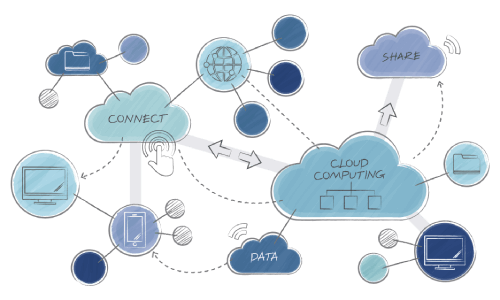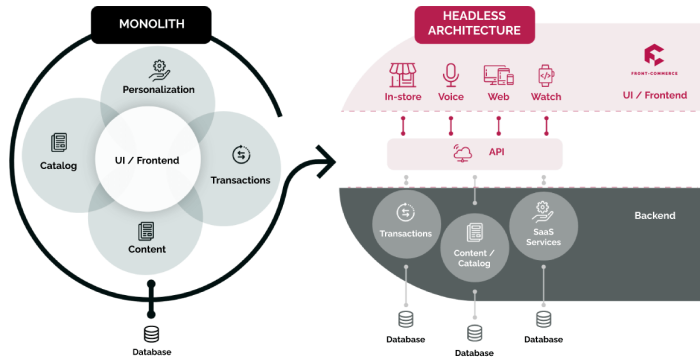A holistic approach to supply chain optimization
In e-commerce, streamlining operations and optimizing the supply chain are crucial for boosting efficiency, cutting costs, and better revenue growth. An agile and efficient supply chain is vital to meet evolving customer demands, manage inventory effectively, and ensure timely order fulfillment.
Tools such as an OMS, cloud based solutions or blockchain, can an be integrated into your e-commerce platform to significantly improve supply chain operations and efficiency. However, the integration of such technology can be more or less complicated, according to your system setup and architecture.
Read on to find out what methods and tools are available, and how to ensure your e-commerce platform is ready to take them on.
Transforming supply chain management with cloud-based solutions
Revolutionizing supply chain management, cloud-based solutions offer automation, data analytics, improved connectivity, scalability, and enhanced efficiency. These solutions leverage cloud computing to automate key processes, enabling companies to optimize nearly every step of their supply chains. By embracing cloud-based solutions, businesses centralize data, decrease costs, and gain end-to-end visibility. Cloud supply chain software operates on a flexible, usage-based model, fostering adaptability and integration of people, processes, and technology.
The benefits of cloud-based solutions for supply chain management include cost savings, increased efficiency, scalability, improved collaboration, enhanced visibility, and reduced operational costs.
Integrating a headless and composable frontend solution for e-commerce significantly enhances connectivity throughout the supply chain. Headless commerce architectures empower businesses to adapt quickly to changing market demands by decoupling the front-end from the back-end.
What are the key advantages of using cloud-based solutions for supply chain management?
1. Increased efficiency
2. Cost savings
3. Scalability
4. Improved collaboration and connectivity
5. Enhanced visibility
6. Reduced operational costs
Optimizing inventory levels and reducing waste
To enhance operational efficiency and reduce waste, implement best practices:
- Forecast demand: Utilize historical data and predictive analytics for accurate demand forecasting.
- Continuous evaluation: Set inventory performance KPIs and conduct periodic data analysis.
- Inventory management software: Automate and streamline inventory management processes.
- Just-in-Time (JIT) inventory management: Stock products only when needed, reducing storage costs.
- ABC analysis and prioritization: Categorize inventory to prioritize high-value products.
Gain a competitive edge with data-driven insights
Data-driven insights play a pivotal role in optimizing e-commerce supply chain operations. Leveraging data, businesses can identify areas for improvement and enhance their supply chain practices. Through the collection and analysis of data from relevant sources within the supply chain, including sales, operations, and logistics, companies can make informed decisions to manage inventories more effectively.
By leveraging data, businesses can optimize e-commerce supply chain operations by:
- Gaining insights into product demand, customer preferences, and seasonal trends.
- Tracking inventory levels, stock movements, and lead times.
- Using logistics data to track shipments and identify areas for cost-savings.
- Understanding customer behavior for demand prediction and personalized marketing.
- Analyzing supplier performance for procurement optimization and cost reduction.
How can your e-commerce architecture optimize your supply chain data?

Modern data architectures and technologies, such as a cloud-based infrastructure, AI, and machine learning algorithms, enable efficient data storage, real-time monitoring, and analysis. Advanced inventory management systems leverage data and computational ability for data-driven decision-making, demand forecasting, and route optimization. Headless commerce architectures provide greater flexibility in integrating these various services and technologies.
Embracing blockchain technology for unparalleled traceability
Integrating blockchain technology into the e-commerce supply chain offers benefits such as improved traceability, transparency, efficiency, collaboration, and reduced fraud. Blockchain enhances collaboration among stakeholders, for a more sustainable and ethical supply chain.
Integrating a headless frontend solution with blockchain technology ensures seamless connectivity, control, and visibility at every stage. The headless architecture provides a flexible API-driven solution that can be integrated with any front-end technology, such as React, Angular, or Vue.js, offering flexibility for seamless integration.
Your frontend solution is key for e-commerce supply chain control
Choosing a headless frontend solution will help ensure control and visibility in your supply chain by providing a flexible and customizable approach to integrating with the various technologies and systems. A headless frontend solution reduces supply chain complexity by offering flexibility and customization in presenting and managing supply chain data. It seamlessly integrates with various services and technologies, including blockchain, improving traceability and transparency throughout the supply chain.
- Flexibility and customization: Present and manage supply chain data with more control.
- Seamless integration: Integrates with various supply chain services and technologies, including blockchain.
- Reduced IT Complexity: Allows for easier adjustments to the supply chain system as changes to the backend can be made without disrupting e-commerce operations.

Navigating the future of e-Commerce operations
By leveraging a headless architecture, e-commerce businesses can easily integrate the technology and systems needed to achieve enhanced traceability, transparency, and control. This integration leads to more efficient and secure supply chain operations, ensuring your business is well-positioned for the future of e-commerce.
